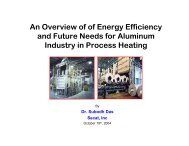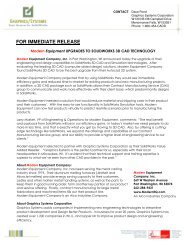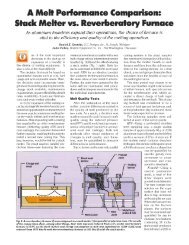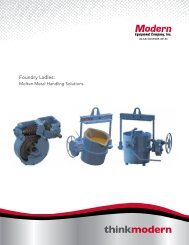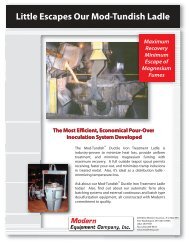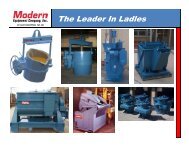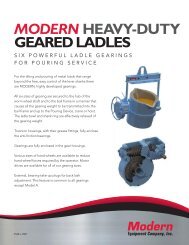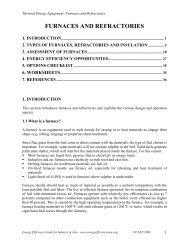ITP Metal Casting: Advanced Melting Technologies: Energy Saving ...
ITP Metal Casting: Advanced Melting Technologies: Energy Saving ...
ITP Metal Casting: Advanced Melting Technologies: Energy Saving ...
Create successful ePaper yourself
Turn your PDF publications into a flip-book with our unique Google optimized e-Paper software.
transfer rate and reduced time required to melt the charge. This, in turn, would increase the<br />
productivity and cut down the energy lost through the furnace walls. The ratio of air (or<br />
oxygen) to fuel in the furnace is also crucial. Too little air will result in unburnt and wasted<br />
fuel, while excess air will waste energy in heating the additional air mass. Flue stack energy<br />
can be recovered to some degree if a regenerator or a recuperator is placed in the path of the<br />
exhaust gases and used to heat the incoming combustion air or if the flue gases can be used to<br />
preheat the metal charge.<br />
2. <strong>Metal</strong> Loss: The surface of the molten metal can oxidize leading to substantial metal loss in<br />
the form of “slag” (term associated with ferrous alloys such as steel) or “dross” (in case of<br />
non-ferrous alloys such as aluminum). This lost metal must be replaced by new metal. The<br />
extent of the metal loss depends upon the affinity of the molten constituents for oxygen and<br />
the melting method. These losses are the highest in aluminum-magnesium alloys. 6 Molten<br />
metal loss is a serious issue when considering a furnace design. If the metal losses are high,<br />
the overall operation would be inherently inefficient and uneconomical.<br />
3. Radiation Losses: These occur as energy emitted from hot furnace and enclosure surfaces.<br />
When the furnace lid or door is opened for charging and tapping, radiation heat losses<br />
increase significantly. Radiation losses from an uncovered bath can reach up to130 kWh/hr<br />
(0.44 MBtu/hr) for an iron furnace with a 10-ton capacity.<br />
4. Conduction and Convection Losses: These losses can be controlled by using suitable<br />
refractory materials and maintaining a tight fit between the lid and the furnace body.<br />
5. Slag/Dross Removal: This can also contribute to energy loss. The extent depends on the<br />
temperature, the composition of the slag/dross, the technique used and how long the furnace<br />
is left open to remove the slag/dross. This loss is not substantial to affect the overall furnace<br />
efficiency, unless huge amounts of slag/dross are removed.<br />
The extent of these energy losses vary depending on the furnace design, operating practices,<br />
metals being melted and the source of energy being used. Exhibit 6 displays a breakdown of the<br />
energy consumption (different forms of energy loss and energy used in melting) for ferrous and<br />
non-ferrous melting.<br />
<strong>Energy</strong> Spent Ferrous <strong>Melting</strong> 7,8<br />
Non-Ferrous <strong>Melting</strong> 9,10<br />
Stack Losses (flue gases) 0 to 50% 35 to 50%<br />
Dross/Slag 0 to 10% 10 to 20%<br />
Radiation/Conduction/Convection 10 to 50% 0 to 10% *<br />
Molten <strong>Metal</strong> 40 to 80% †<br />
10 to 40%<br />
* Heat lost from walls<br />
† The ferrous melting efficiency is much lower than listed due to the use of electricity, which involves sizeable energy losses<br />
during generation and transmission.<br />
Exhibit 6: Heat loss through various modes and useful energy<br />
7



